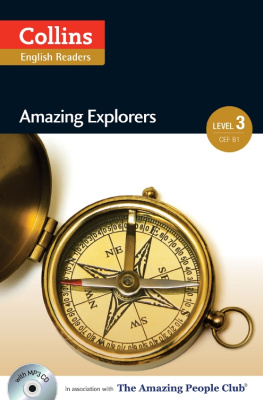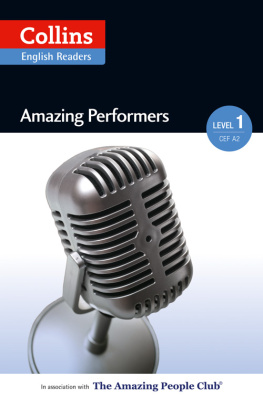You can choose to enjoy the book from start to finish or to dip into your favourite story straight away. Each story is entirely independent.
After every story a short timeline brings together the most important events in each persons life into one short report. The timeline is a useful tool for revision purposes.
Words which are above the required reading level are underlined the first time they appear in each story. All underlined words are defined in the glossary at the back of the book. Levels 1 and 2 take their definitions from the Collins COBUILD Essential English Dictionary and levels 3 and 4 from the Collins COBUILD Advanced English Dictionary.
To support both teachers and learners, additional materials are available online at www.collinselt.com/readers.
The Collins COBUILD Grading Scheme has been created using the most up-to-date language usage information available today. Each level is guided by a brand new comprehensive grammar and vocabulary framework, ensuring that the series will perfectly match readers abilities.
For more information on the Collins COBUILD Grading Scheme, including a full list of the grammar structures found at each level, go to www.collinselt.com/readers/gradingscheme.

17431794
the man who wrote the first modern chemistry textbook

I was a French scientist, who people call the founder of modern chemistry. With my wifes help, I wrote the first modern textbook on chemistry. I discovered what water consists of. I died on the guillotine in the French Revolution .

I was born in Paris on 26th August 1743 into a family of rich aristocrats . When I was only 5 years old, my mother died, and left me a lot of money. From the age of 11, I went to a very good school, the Collge des Quatre-Nations (also known as the Collge Mazarin), where I studied chemistry, mathematics, astronomy and botany . My father was a lawyer, so my family expected that Id follow the same profession. But although I studied law, I didnt want to be a lawyer. I was much more interested in science.
In 1766, I wrote an essay with a plan for lighting the streets of Paris. I felt very proud when I received a gold medal from King Louis XV for my essay. I also studied geology, the science of the study of rocks. In 1767, I worked with a team of geologists on a study of the rocks of Alsace-Lorraine.
In 1768, when I was 25, I was elected to the Academy of Sciences, the most important organization for scientists in France. In the same year, I started working in the administration of the Ferme Gnrale, a private company that collected taxes for the king. The Ferme Gnrale was hated by the poor peasants of France. Many of the people who collected taxes for the Ferme Gnrale were very rich, but they didnt earn their money in an honest way. They gave some of the tax money they collected to the King, but they also kept a lot of money for themselves.
I knew this was wrong, and I tried to help the poor peasants. But Id no idea that one day Id die because Id worked for the Ferme Gnrale.
I was very surprised when one of my work colleagues, an older man called Jacques Paulze, asked me if he could talk to me about his daughter, Marie-Anne. He told me that she lived in a convent . However, a rich and powerful aristocrat called the Count dAmerval wanted to marry her. But Marie-Anne didnt want to marry the Count, as he was almost 40 and she was only 13. This made the Count very angry. He said that if Marie-Anne didnt marry him, he would remove Jacques from his job at the Ferme Gnrale.
So Jacques asked me if Id marry Marie-Anne. If she had a husband already, the Count wouldnt be able to marry her. So I agreed to meet Marie-Anne. I was 28, but in spite of the 15-year difference between our ages, Marie-Anne and I liked each other, so we married on 16th December 1771.

Marie-Anne continued her education at the convent, but we met sometimes, and we liked each other more and more. She was very interested in my scientific work, and wanted to learn more about it. After leaving the convent, she began to help me in my work, and for the next twenty years, we worked together as a team.
Marie-Anne had learned English, so she was able to translate the works of English scientists, for example, the chemist, Joseph Priestley. This was very useful for me, as it meant I could learn what scientists in other countries were doing. Marie-Anne was also very good at drawing, and she drew excellent diagrams of my experiments. In addition, she helped me write scientific papers , and kept records of my experiments and discoveries.

Antoine with Marie-Anne
My work with the Ferme Gnrale kept me very busy. But in 1775, I was appointed to a new and important job when I became one of four Commissioners of the Royal Gunpowder Administration. There had been some problems with the quality of the gunpowder used in France, but after I started working for the Royal Gunpowder Administration, the quality improved a lot.
My new job was very good for my career as a scientist. I was given a house and a laboratory in the Royal Arsenal, the buildings where the armys equipment was stored. Marie-Anne and I lived and worked there between 1775 and 1792. We often gave parties for other scientists, and they enjoyed visiting us to discuss their work and ideas.















